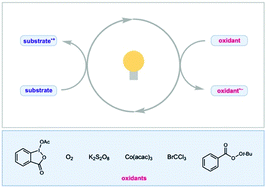Oxidase reactions in photoredox catalysis
Abstract
The nature of the terminal oxidant in oxidation reactions is an important reaction variable that can profoundly impact the mechanism, efficiency, and practicality of a synthetic protocol. One might reasonably categorize catalytic oxidation reactions into either “oxygenase” type reactions, in which the oxidant serves as an atom- or group-transfer reagent, or “oxidase” type reactions, where the oxidant is involved in catalyst turnover but does not become structurally incorporated into the product. As the field of photoredox catalysis has matured over the past decade, many successful oxygenase-type photoreactions have been reported. The development of photocatalytic oxidase reactions, on the other hand, has been somewhat slower. This tutorial review presents selected examples of some of the key classes of terminal oxidants that have been used in the design of photoredox oxidase transformations, along with the mechanistic features and benefits of each.



 Please wait while we load your content...
Please wait while we load your content...